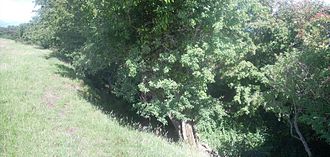Dun Aulin

Dun Aulin, also knon by its Irish language name, Dún Ailinne, is an ancient ceremonial site on the hill of Knockaulin in County Kildare. It is to be found southwest of Kilcullen, near the N78 road to Athy.
The site is a large circular enclosure covering most of the hilltop; about thirty-two ares. Archeological investigations show that there were once circular timber structures (or rings of upright timbers) inside the enclosure.
According to Irish mythology, Dun Aulin was one of the great royal sites of early Gaelic Ireland and is believed to have been where the Kings of Leinster were inaugurated. It is similar to the other royal sites: Tara of the Kings of Meath, Navan Fort of the Kings of Ulster and Rathcroghan of the Kings of Connaught.
The hill reaches 600 feet above sea level. Its name in Irish is Cnoc Ailinne (which is confusingly similar to that of Cnoc Alúine, the Hill of Allen, to the north-west).
History and purpose
- Location map: 53°6’54"N, 6°46’30"W
The site is circular, about 32 acres in area, ringed by an earthen bank and ditch (or "henge"). As with most henges, the ditch is on the inside, meaning that it was likely to have been symbolic rather than defensive.
It is believed that Dún Ailinne was a royal centre and inaugural or ceremonial site for the Kings of Leinster. In terms of its ritual use, the internal structures and layout, and its location and association, is similar to the other royal sites of Tara, Navan Fort and Rathcroghan.[1]
Indications of earliest use are from the Neolithic period, but the main activity there was during the Iron Age. It does not seem to have been dwelt in year-round, but was instead mostly used for short-term activity, including ritual. It seems to have been occupied during the Spring/Summer months and there is evidence of cooking, which include a great deal of bone from cows, sheep, pigs, deer and horses.[2][3] A La Tène style sword and Roman bronze fibulae have also been found at the site.[3]
While it figures in some early historical references, Dun Aulin was mostly abandoned about the time the nearby early Christian settlement at Old Kilcullen was established in the 6th century.
Structures
Excavations during the 1960s and 1970s found that there were once timber structures within the ring. There were three phases of construction, each including rings of upright timber posts. One of these, the Rose phase, had a figure of eight layout, with one large ring, an annexe to the south, and an elaborate funnel-shaped entrance. The later Mauve phase had a stakewall, within which were a timber ring and smaller, closed, circular structure. The last phase was characterized by ceremonial feasting, indicated by a large amount of animal bone.[3]
Study
Dún Ailinne was the subject of archeological research between 1968 and 1975 by a team from the University of Pennsylvania led by Bernard Wailes. More recently, a geophysical survey of the interior was carried out by a joint American and Irish team. This revealed a large number of new subsurface features whose character is unclear.
Following some scholarly journal publications, a book was released by an American university publisher in 2007, by Bernard Wailes and Susan Johnston.
In 2008, an interpretative site was opened at Nicholastown, a townland just south of Kilcullen, featuring a small-scale reproduction of the mound, topped by a sculpture.
Current status and access
The whole site is on private farmland and casual access is restricted due to difficulties with livestock; in general, the owners of the land have no problem with people having a stroll as long as they ask permission beforehand at the farmhouse just on the north-east side of the hill beside the N78 road.
References
- MacKillop, James: 'Oxford Dictionary of Celtic Mythology' (Oxford University Press, 1998) ISBN 0-19-860967-1
- Raftery, Barry: 'Pagan Celtic Ireland: The Enigma of the Irish Iron Age' (Thames & Hudson, 1994) ISBN 0-500-27983-7
- Johnston, Susan; Campana, Douglas; Crabtree, Pam: 'A geophysical survey at Dún Ailinne, County Kildare, Ireland' (Journal of Field Archaeology 34:385–402, 2009